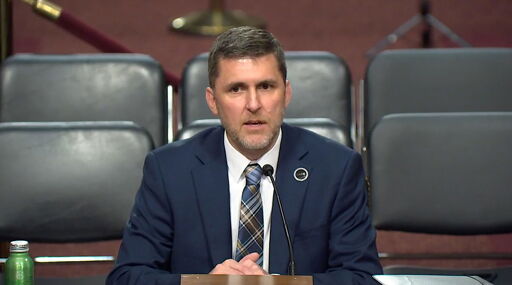- 61 Posts
- 41 Comments

 12·5 months ago
12·5 months agoThe survey was done of U.S. citizens. You can look up the survey on YouGov.com to see the population surveyed. The survey is titled “Democracy, Trump, and Musk”
Target population: U.S. Citizens, aged 18 and over.
Sampling method: Respondents were selected from YouGov’s opt-in panel to be representative of adult U.S. citizens.
As noted in their “about” page, YouGov does international research. https://today.yougov.com/about
With operations in the UK, the Americas, Europe, the Middle East, India and Asia Pacific, we have one of the world’s largest research networks.

 6·6 months ago
6·6 months agoJames Clapper was Director of National Intelligence and Jay Stratton was director of the UAP task force. One of the main issues with the idea of proof being disclosed to the public is that it’s classified. These are two of the most prominent people to come forward to have knowledge of these programs and classified records. While they’re not going to pull out a classified folder to show on film, they can vouch that such programs exist and that claims of NHI and non-human origins of UAP are real. The fact that the story is the same, but validated by people higher up in organizations than those that spoke before them is advancing the conversation.
And advancing the discussion is not the same as providing proof. If you want proof then pressure law makers to pass more laws like the UAP Disclosure Act or you can do research and file FOIAs. Many are discouraging testimony because it’s been said before, but that just creates a stigma on the topic as a whole. Evidence won’t be released if no one is interested. A film like this, which is being featured at SXSW, will stir up more interest and with luck help create political pressure to release records of the programs and history being alleged.

 4·6 months ago
4·6 months agoI’m looking forward to it as well. Having James Clapper speak on the topic is big. And, Jay Stratton’s claims of actually seeing non-human craft and non-human beings will make him one of the most notable first hand witness to date. I’m sure a lot of people will complain that it doesn’t have the evidence they need for proof, but it should at least advance the discussion.

 7·8 months ago
7·8 months agoUnidentified drones can also be UFO until identified. The main reason the Pentagon researches UAP is to assess potential threats and identify potential new technologies. There’s a wide range of objects and phenomena being researched. And, a part of understanding UAP is learning of new and emerging drone technology.

 51·8 months ago
51·8 months agoYeah, I’m not necessarily a fan of his other work, but he’ll be talking about his report on Immaculate Constellation.
Personally, I’m patient and will withhold judgement until after the hearing happens.

 31·8 months ago
31·8 months agoIt’s a couple days away, so there’s no need to jump to conclusions one way or the other now. Just wait and see how it pans out. And, there are links to the witness statements and bios in the link of this post if you’re not familiar with them.

 4·9 months ago
4·9 months agoI always look forward to Marik’s articles. They’re a great way to catch up on recent events and how they tie into UAP history. And, as always, this article is abundant with citations.
We’ve already seen one roadblock with what little passed of the UAP Disclosure Act in the last NDAA. The expectation was that government agencies would have to transfer records relating to UAP to the National Archives by Oct. 20th. However, some ambiguity in the text that passed only required agencies to organize in preparation of transferring. The National Archives has now mandated the transfer to take place no later than September 30, 2025. They also recently confirmed that no records have been transferred.
Though there may be a wait, the National Archives already has an abundance of records and have continued uploading more over the last month. There are close to 13,000 records related to UAP, with quite a few not listed in their topic research page and plenty that are remaining to be digitized. I’ve been in contact with them about the status of these records, slowly getting updates and seeing issues getting addressed on their site. I have a few lingering questions and will hopefully have a more thorough update for the community soon.
In the meantime, checkout the below links for more information on the state of UAP records at the National Archives.
Records Related to Unidentified Anomalous Phenomena (UAPs) at the National Archives

 7·9 months ago
7·9 months agoLink to the PDF: https://documents2.theblackvault.com/documents/navy/DON-NAVY-2021-008741.pdf
There’s not a ton of substance released, but it does give some insight into the UAP Task Force, reporting, stigmas faced, and the “Tic Tac” encounter. The final slide seems fitting after multiple fully redacted pages. “Questions?”

 2·9 months ago
2·9 months agoJust received an email from NARA’s public affairs, which mainly states what I posted. Hopefully, I can still get some more info on the metadata.
Thank you for contacting the National Archives to inquire about UAP records. This message serves to provide you with some newly available information:
We recently published an FAQ page on this topic. Here is the link - https://www.archives.gov/research/topics/uaps/faqs.
Additionally, here is a link to the latest AC memo - https://www.archives.gov/records-mgmt/memos/ac-04-2025
Best, Public and Media Communications staff

 5·9 months ago
5·9 months agoSome NARA resources on UAP:
- Records Related to Unidentified Anomalous Phenomena (UAPs) at the National Archives
- Unidentified Anomalous Phenomena Records Collection, December 23, 2023–2024
- Bulk Downloads for Records Related to Unidentified Anomalous Phenomena (UAPs)
- Guidance to Federal Agencies on Unidentified Anomalous Phenomena Records Collection
- Memorandum AC 13.2024
- Memorandum AC 26.2024
- Memorandum AC 39.2024
- Memorandum AC 04.2025
- FAQs (Just added today.)

 5·9 months ago
5·9 months agoI’ve been on a wild goose chase asking around the National Archives for clarification on the UAP records transfers. I had some emails in limbo for months with no responses and just started getting traction of being referred to various emails. I mainly wanted to confirm the date agencies are expected to comply and I was requesting copies of the metadata spreadsheets that will be provided by each agency. Perhaps coincidentally, NARA just released a new memorandum today confirming September 30, 2025 as the date agencies are expected to transfer records. Keep in mind that NARA would have 30 days after receipt to make records publicly accessible on-site and 180 days to upload to their site.
The memorandum touches on the metadata I’ve been asking about, but still no word on making the full metadata spreadsheets publicly available. The metadata spreadsheets would make it clear what each agency is transferring and help better track compliance. I reached out to projects.researchservices@nara.gov earlier this week, though I’m still awaiting a response.
In the meantime, I’ve been tagging UAP records on their site. I’ve found quite a few records that haven’t been added to their main UAP page. However, I’ve also seemed to reach a limit with their search page. Searching for user tags on their site is buggy, but NARA confirmed their tech team is working on optimizing this search feature. There is also a 10,000 record cap on searches and user tag results aren’t properly displaying total records. This also put a snag in my tagging, since I was going to export all result IDs to match up against search terms to see what records are left to tag. Hopefully their upcoming fix will help with that.
So, a bit of a wait for agencies to comply. Though, some could start trickling in from now until that date. There’s ample that NARA already had online that’s well worth checking until then.

 151·9 months ago
151·9 months ago“Immaculate Constellation” is the name of the program, since it seems to be cut off by a paywall.
We’re roughly a month from both the Senate and House’s UAP hearings. The Senate will focus on AARO, which could still be interesting since they’re under new leadership. However, the House will have a broad scope and has potential to bring in a range of witnesses. If such a program does exist then hopefully we can get a witness in the hearing that can shine more light on it.

 3·10 months ago
3·10 months agoCredit to Reddit user randonaut for helping get this page established. The downloads mirror the collections outlined on the main UAP landing page. Do note that the content here is just what was already in possession of the National Archives and doesn’t reflect transfers from other government agencies. This also doesn’t seem to fully encompass the National Archive’s records either, as I have been tagging UAP related records and have come across plenty that haven’t been added to that collection. They do at least seem committed to updating these pages somewhat frequently.
I’ve also been reaching out the National Archives to confirm the status of the transfers mandated by the last NDAA. However, I’ve not gotten a hold of anyone yet that seems to have definitive information on the subject. Speaking with randonaut, I’ve at least got insight into the contact that set up the bulk download page and I’ve also reached out to additional departments there. One of my current goals is to see if the metadata spreadsheets from each agency can be shared to track who is complying and what is being transferred.

 3·10 months ago
3·10 months agoI see a lot of defeatism in other communities with news like this. It’s always good to temper expectations in advance, know that it’ll take time, and that set backs are to be expected. Regardless, it’s clear that more information will come out soon and shine a better light on what’s going on.

 6·10 months ago
6·10 months agoIt’s important to note that some amendments related to UAP and whistleblower protections were already included and will be up for consideration. There’s still potential for changes to the final NDAA, though I wouldn’t expect anything substantial outside of what’s already included.
That said, there should be UAP record transfers to the National Archives over the next month or so. It may take time for the records to be uploaded online, but they should be available for viewing in person at the archives within 30 days of their receipt. On top of that, there will be hearings in both the House and Senate in November. So, the UAPDA not getting included in this year’s NDAA should be viewed as a set back, but not a stop in momentum.

 6·10 months ago
6·10 months agoIn the next few months we should hopefully have an update to that page as the 2025 NDAA is passed. There are two UAP hearings in the works with the Senate and House that could help push for more of the UAPDA to pass this year. I’m not hopeful that everything will pass, but each bit that passes will make an impact.
I’ve been keeping an eye on the National Archives and trying to get a hold of someone there that confirm if any agency has complied with the record transfers outlined in the 2024 NDAA. Agencies just have a month left to comply, but so far nothing has been updated online besides what the archives already had in its possession. Even then, there seems to be documents that they haven’t uploaded online or added to their UAP topics page. In the meantime I’ve been helping tag UAP related records. There are already a lot of interesting historical records online, so I can only imagine what different agencies have in their possessions.

 4·11 months ago
4·11 months agoI just got his book, “Imminent”, and I’m curious what it will add to the discussion. It seems like the book and his recent appearances are aimed at reaching a broader audience than the typical UAP community. If the content is accessible and understandable to a general audience, then this could help build public interest in the topic.
This could also help stir additional whistleblowers or those with knowledge to speak out about these programs. Just yesterday in response to this book, Harald Malmgren stated on Twitter/X: ““Imminent” a book to be published tomorrow, Aug 20, by Luis Elizondo on what our government knows about UAP, or alien visitors to Earth. This book breaches a dam & I expect will likely be gradually followed by more awakening disclosures ahead”
And his follow up tweet: “60+ years ago I was provided highest level classifications to lead DOD work on nuclear weapons&anti-missile defense. Informally briefed on “otherworld technologies” by CIA’s Richard Bissel (who had been in charge of Skunkworks, Area 51, Los Alamos, etc.) but sworn to secrecy.”
These books, articles, and public statements can help put pressure on the government, particularly Congress, into seeking transparency on these programs. The UAP amendment is still in the works to be added to this year’s NDAA, so public interest could be pivotal in getting the amendment passed in full or at least build off of last year’s amendment.
Awesome photo. Though, I was thrown off by the picture. In the US we often refer to vultures as buzzards and we would likely refer to this as a hawk. I’m not sure how we messed that one up.
Where I grew up had a ton of Red-tailed Hawks and the occasional Swallow-tailed Kites. I always love seeing and hearing them around.

 4·11 months ago
4·11 months agoThat is quite a bit to go through. I actually just started a dive into UAP documents at the National Archives, so I’ve already got a pile of reading ahead of me. However, I’ll set aside some time later to glance over this.
I personally go into this subject open minded and try not to get too wrapped up in assumptions on what occurs. Incidents can vary drastically, though there are also common themes that come up in a lot of encounters. While I don’t have many specific beliefs on the phenomenon, I do appreciate people sharing their experiences and thoughts on what’s occurring.










These parties are geared at gathering children together to spread measles amongst the children. The parents arranging it are likely vaccinated, so the harm is focused on the kids. You’re suggesting that these kids should get sick and possibly die to spite your enemies.
Not to mention that vaccines are only 97% effective, so spread to vaccinated people is likely. https://www.cdc.gov/vaccines/vpd/mmr/public/index.html
Add to that the fact that measles can also essentially reset the immune system making people lose the effectiveness of vaccines for other diseases. https://www.bbc.com/future/article/20211112-the-people-with-immune-amnesia
But, that’s all ok just to spite your enemies? Innocent children should be subjected to measles and the general public should be endangered?